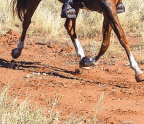Rescue horse confidential

The arrival of a new horse in your life is always exciting. The possibilities for your partnership stretch ahead like a sunlit road waiting to be traveled together. Acquiring a rescue horse, however, is very different from buying a healthy, sound horse who has had excellent care throughout his life. A rescue horse with an unknown past may behave in surprising ways, and his health may be compromised in ways that can never be fully restored. An owner of a rescued horse recently put it this way, “I guess that is the hard thing about rescue. You never know what is going to happen.” The road ahead may have a few clouds along with that sun, and it may take some unexpected turns.
Through my veterinary practice, I have been along for the roller coaster ride that rescue cases often become. I have experienced the joy of nursing a horse back to health, and watching him become strong and confident. I have also watched horses die despite every person’s best efforts to save them. And, while there are no guarantees, I know rescue horses do best when owners have up-todate information and a network of support.
The American Association of Equine Practitioners (AAEP) has published and regularly updates Care Guidelines for Equine Rescue and Retirement Facilities. These guidelines provide a road map, which veterinarians follow as much as possible. But each rescue horse is unique. You’ll need to be ready to adapt to each horse’s needs and circumstances. Taking on a rescue horse requires patience and dedication, and it can be one of the most rewarding experiences a horseperson can have. Here’s my advice for how to begin.
ATTEND TO BASIC HEALTH NEEDS
As soon as you take legal ownership of a rescue horse, ask your veterinarian to conduct a full physical exam. Ideally, you’d schedule this ahead of time and can have it done the very same day the horse comes into your possession. If you adopted the horse through a rescue organization, he probably has received some veterinary attention and records may be available. But you’ll want your own veterinarian to get to know the horse. A one-on-one visit may also
You’re reading a preview, subscribe to read more.
Start your free 30 days





